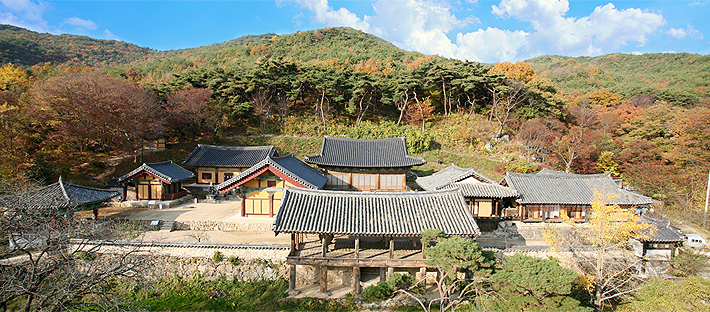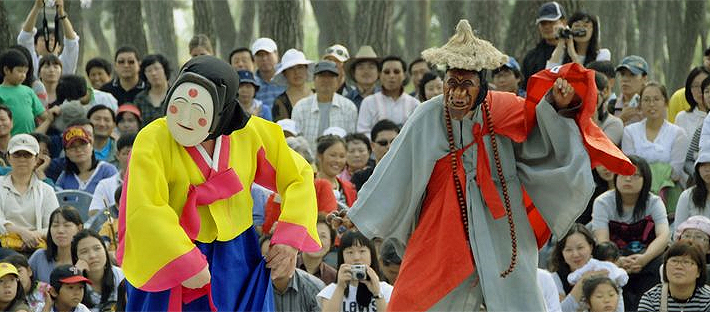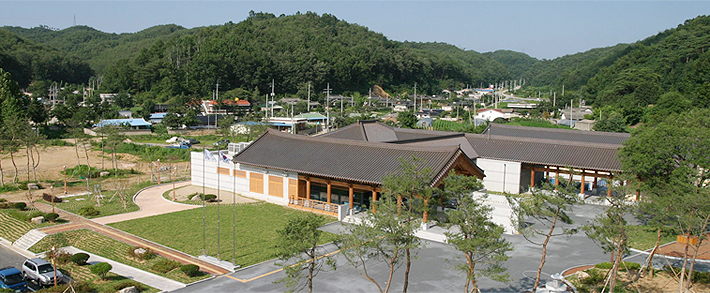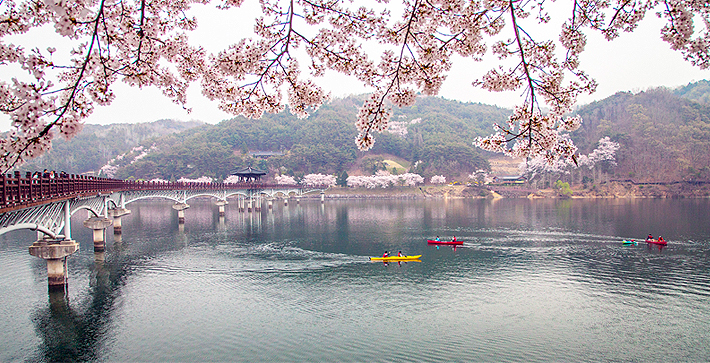Tourist Attractions
Andong, the Capital of Korean Spirit
Hahoe Village with living and breathing Korean Beauty & Tradition

Important Folklore Material No.122
This is a village whose main habitants are of the Pungsan Ryu clan. It is called Hahoe because the river Nakdong flows around the village in an S-shape. The village is set in a scene of unsurpassed beauty.
Three mountains and a dense pine forest encircle it like folding screens. The river Nakdong flows smoothly by, bordered by sandy beaches. Overhead rears the strange rock shapes of Buyongdae cliff. The village itself contains various typical Korean houses preserved since the early Joseon Dynasty. Folk performances such as Hahoe Maskdance and Seonyu-Julbul-Nori(traditional fireworks) are still played, thereby making this village an ideal place to understand the traditional culture of Andong. The Korean folk village HA HOE is designated as World Heritage by UNESCO since 31th. Jul. 2010.
Confucian Culture having placed high value on Study and Courtesy, Dosan Seowon (Confucian Academy)

Historic Site No. 170
Korea’s preeminent Confucian scholar, Lee Hwang(1501-70), established Dosan Seodang(confucian academy) to devote his life to study and the education of his disciples. Shortly after his death, his disciples and scholars established Dosan Confucian academy to commemorate his lofty virtue. In the eighth year of King Seonjo’s reign (1575), a carved tablet written by Han Seok-bong(1543-1605), a famed calligrapher of the time, was dedicated here. Dosan Confucian academy is comprised of Dosan Seodang(classroom), Nongunjeongsa dormitory, Gwangmyeongshil (library), Jeongyodang hall(lecture hall), Sangdeok Shrine and Jangpangak (storage for wooden block). Dosan Confucian academy, bordered by Lake Andong in front and dense pine forests at the back, creates a harmonious scenery. Dosan Seown was designated as World Heritage by UNESCO in 2019.
Buddhist holy land cherishing the historical depth of five thousand years, Bongjeongsa Temple Temples available for temple stay program

During the twelfth year of King Munmu’s reign during the Silla Dynasty (672), Monk Euisang flew a paper phoenix into the sky from Buseoksa Temple. It was said that the temple was constructed on the site where this paper phoenix was placed, and thus called‘ Bongjeongsa Temple.’‘( Bong’means phoenix, while‘ Jeong’means stay).
It contains many cultural artifacts, such as Geuk’rakjeon, the oldest wooden building in Korea. Daeungjeon, Hwawomkangdang, and Gokumdang were constructed during the Joseon Dynasty (1392-1910), containing valuable materials for architectural research. Additionally, there are three-story pagodas called Deokhuiru, Yosachae, and several small Buddhist temples, such as Yeongsanam hall and Jijoam hall.
Bongjeongsa Temple was designated UNESCO World Heritage in 2018.
Town keeping festival and the tradition of colorful folk culture

Andong International Maskdance Festival
Andong International Maskdance festival is held every September for the purpose of developing Andong and Korea as a worldclass tourist destination. The festival consists of various traditional dances from all over the world. Citizens from all over the world get together at Andong to participate in Korea’s largest culture tourism festival. The festival brings the world to one.
Roofless Museum City, Andong

Recently there has been increasing interest in hands-on travels that include hand-on experience in unique traditional culture and history. The City of Andong is home to a variety of museums, including 22 natural, traditional culture and digital museums, that attract approximately two million tourists every year who are interested in hands-on activities. The city, therefore, is considered to be a roofless museum city that provides an enjoyable hands-on learning experience in unique traditional culture.
House is in nature, all outside the house is garden

Andong is bordered by Taebaeksan Mountain to the east and Sobaeksan Mountain in the northwest. A low hillock where the Nakdonggang River flows is located at the center, which consists of a pristine, green lake and an unparalleled scenery. Andong’s natural beauty resounds with the mystery of ancient times: steep cliffs full of uniquely shaped rocks, and hot springs and dense forests constantly changing with the seasons. Like a renowned statue carefully sculpted, Andong’s cultural heritage sites rest in subliminal harmony with its natural beauty, which gives one a sense that poetry and art lie hidden in each and every scene.
Wolyeong-gyo Bridge

The largest wooden bridge in the nation with 3.6m wide and 387m long, Wolyeong-gyo Bridge is in harmony with moonlight on the lake and mountains surrounding the Nakdonggang River, which remind us of a part of an Oriental painting. Nearby are the Palgak-jeong Pavilion and fountains, all of which add another beauty to the area.





